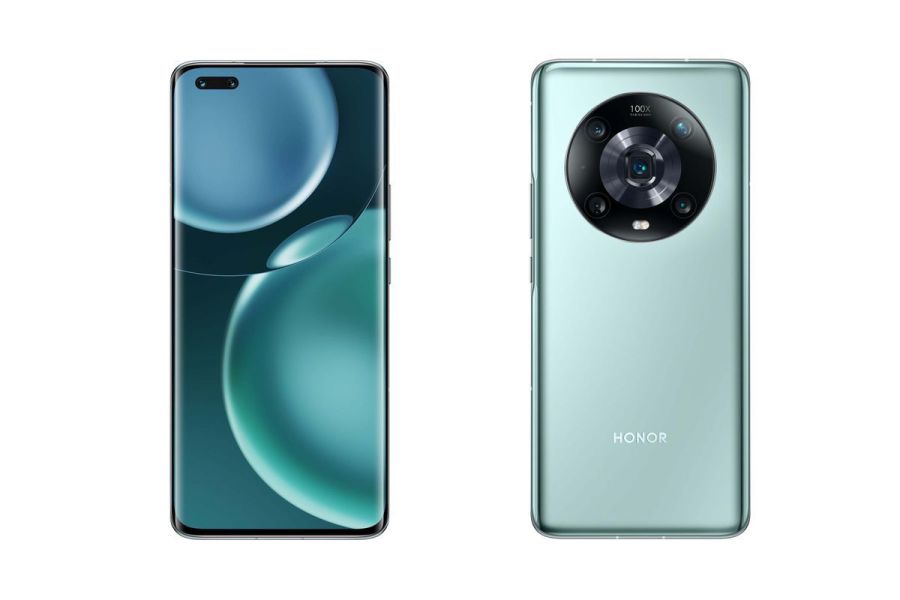The Honor Magic4 Pro is the first flagship phone from fast-growing Chinese smartphone maker Honor, now independent from former owner Huawei. As well as being able to run all the Google apps, it features a wide/ultrawide camera combination, backed up by a 64MP telephoto plus a ToF (Time of Flight) depth sensor. Geoff Harris sees if it stands out in a tough market, given its £950 price tag.

Honor Magic4 Pro features
As Honor’s flagship phone, the Magic4 Pro has an impressive feature set. The main camera is a 50MP, f/1.8 device, while the ultra-wide offers 50MP and f/2.2 and the telephoto 64MP at f/3.5. The telephoto comes with optical image stabilisation (OIS), which is lacking from the main camera (more on this later). The dual front camera, meanwhile, offers 12MP for selfies.

The rear camera layout won’t be to everyone’s taste
The periscope-style telephoto lens extends to 3.5x optical zoom on the back, and there’s the usual extended digital zoom (100x). Zoom out this far however and the images rapidly deteriorate, but Honor is not alone in this.

Bristling with camera features, the design says it all: this is a serious tool for photography
From the get go, we were struck by the crisp and bright 6.81-inch display, with a 120Hz variable refresh rate. The phone looks very stylish too, though the circular design of the rear camera set-up might not be to everyone’s taste. In terms of hardware and memory, you get 8GB of RAM and a reasonable 256GB of storage, while the processor is Qualcommn’s nifty Snapdragon 8 Gen 1. There’s also high-quality video capture, up to 4K at 60fps.

Even without the pricey wireless charger, the phone juices up quickly
This is a very competitive market, so Honor needs to work hard to stand out, and one area where the new phone immediately impresses is battery charging: while the 100W SuperCharge wireless charger is very fast, you need to cough up an eye-watering £85; even via a standard charger, however, it only takes about 40 minutes to fully charge.
Key features
- 50MP f/1.8 main camera
- 50MP f.2.2 ultra wide
- 64MP f/3.5 telephoto (3.5x optical zoom), OIS
- 12MP f/2.2 front camera, with secondary TOF camera
- 6.81-inch OLED screen, 2848 x 1312 pixels
- Android 12 (upgradeable to 13)
- Size 163.6 x 74.7 x 9.15mm
- Weight 215g
Honor Magic4 Pro handling
At 215g the phone is a tad lighter than some rivals, notably the Oppo Find X5 Pro, and the curved glass finish feels nice in the hand (there are black or cyan finishes). That said, it soon gets covered in finger marks and feels slippery, so definitely use the supplied translucent case. Even with the case on, you can fumble, so be careful. It’s a resilient handset, however, offering water and dust resistance thanks to its IP68 certification.
The touchscreen is almost too sensitive and this, combined with the slippery finish, negatively affects the handset’s handling.
Existing Android phone users will soon feel at home with the controls, although navigating back to the home screen when in camera mode, for example, takes more figuring out than it should, even after using the phone for a while. Which brings us back nicely to the big, circular, rear camera unit. You’ll either love or hate it; I’m ambivalent, but one drawback is that it makes it very obvious that this is a powerful camera phone.
It’s an aggressive statement of Honor’s ‘smartphone camera king’ aspirations, but maybe not so great when you want to take street shots without being noticed.
There is a decent range of shooting options, both auto and advanced. As well as a Pro mode for full manual control, two features particularly stand out. Night mode is effective, but the phone also excels in low light rather than full inky blackness. If the phone senses the scene is too dark, it automatically uses the main camera at 3.5x (digital) zoom rather than the periscope telephoto.

Honor Magic4 Pro (digital) telephoto image, 1/100s, f/1.8, ISO354, 86mm equivalent, click to enlarge
I was actually more impressed by the powerful but intuitive panorama mode, which is the best I have seen on an Android phone. The smart AI makes it practically fool-proof and the lack of stabilisation on the main camera doesn’t seem to be a big disadvantage in decent shooting conditions.
All good, but it’s a shame there isn’t a Long Exposure mode in the ‘More’ camera options, as featured on Oppo’s higher-end phones: this would be more useful to photographers than fripperies like ‘Stickers’. Yes, you can get long exposure effects effect in Pro mode, but it’s extra faff.
‘Super-macro’ mode is OK for close-ups but no substitute for a dedicated macro lens.
Focussing is generally impressive, via the grandly named 8×8 dTOF Laser Focusing System, locking on to the subject quickly and accurately, even in so-so light. As the image below shows, the Magic4 Pro can deliver very sharp shots.
In Portrait mode, there is a Bokeh option, which does a decent job of achieving realistic looking background blur, but you need to check it’s turned on, rather than the ‘Beauty’ skin-smoothing, which is the other option. Some might find this an annoying extra step, but sometimes you don’t want lots of bokeh on a portrait so it’s probably best that it is not applied by default. There is also a handy Aperture control in the main camera options, which saves having to dive into Pro mode to control depth of field.
When taking a selfie with the front camera, it defaults back to Portrait mode; you can see why Honor did this, but it can be irritating if you forget to turn off Bokeh and don’t want a defocussed background. Front camera performance is average, but most serious smartphone photographers wouldn’t use it much anyway.
These are small niggles, however, Generally the AI processing and HDR effects work well. Colours can appear over-saturated, but not as lysergic as with comparable Oppo phones, and it’s easy enough to dial this down when editing with apps (or shoot in Pro mode). Also, you can turn the AI processing on and off via the top menu in camera mode for less saturated results.
On the subject of apps, Honor is banging the drum about the AR (augmented reality) features of the new phone. According to the company, it has invested heavily in AI Space Identification, Spatial Audio and support for ARCore “to unlock immersive experiences for smartphone users everywhere.”
I saw the AR capabilities in action at the recent IFA consumer technology show in Germany, using the ARLOOPA app to overlay flora, fauna or fantasy creatures (for example) over shots of Hamburg’s historic docks; while the results can look like something from gaming or digital art, rather than conventional photography, this technology has exciting possibilities, and Honor is right to get in there now.
Honor Magic4 Pro image quality and performance

Honor Magic4 Pro main camera, 1/1997s, f/1.8, ISO50, 27mm equivalent (the wide camera shoots at 27mm equivalent, unless you switch to 50MP, and then you get a 22mm equivalent), click to enlarge
Images from the main camera lens are well balanced and exposed and the colours, while quite strong, are not overpowering. As with rival phones, HDR mode is turned on automatically but the processing is not excessive, and the AI can be toggled on and off. One of the better performances from an Android phone.
The ultra-wide camera performance is good too, though you do get distortion on straight lines and edges, notably with architecture, as can be seen above. This is easily fixed in popular editing apps such as Snapseed, so it’s something you need to allow for.
At 3.5x optical zoom, the telephoto performance is pretty good. Go a lot further beyond that with digital zoom (up to 100x) and image quality starts to fall off. The optical zoom, while effective when it works, can be frustrating to activate and indoors, the phone defaults back to digital zoom without giving you much say in the matter.
The Beauty and Bokeh options in the Portrait mode give a lot of flexibility via sliders, and the bokeh effect is convincing for a smartphone. The Beauty mode smooths skin and adds sympathetic AI lighting effects.
The Panorama mode is a delight to use, with the Magic4 Pro doing a great job of helping you keep things level – just remember there is no stabilisation on the main camera lens, however.
The Night mode is also effective, although not as sophisticated as the Apple iPhone’s feature, and you see its limitations in terms of haloes and artefacts when you zoom right into images. The Honor is a solid low-light performer too, and noise, while present, doesn’t become annoying.
Super Macro mode is okay but nothing special for a £1000 flagship phone, using the ultra-wide angle camera – owners of dedicated macro lenses won’t be trading them in just yet.
Value for Money
The handset is reasonable (rather than outstanding) value at £950 when you consider its many capabilities and is available on contract for around £40 a month with an upfront payment. Although it’s a shame the main camera isn’t stabilised, there is still a lot to like about this phone. If you don’t want to spend this much, you can get the excellent Google Pixel 6 for under £600; it also offers very good image performance, so long as you can live without manual shooting. The higher-end Google Pixel 6 Pro also comes in £100 cheaper, at £849 (or less if you shop around).
Furthermore, the Honor shares similar specs to the OPPO Find X5 Pro, the latter having the advantage of a 32MP front camera and being better looking – though it’s let down by a mere 2x optical zoom on the telephoto camera. There is also the remarkably powerful, albeit rather unwieldy, Samsung Galaxy S22 Ultra for £935 with dual telephoto cameras. A tough choice for Android fans, so Honor certainly can’t rest on its laurels yet.
Honor Magic4 Pro Verdict
As a flagship phone, the Magic4 Pro definitely delivers the goods, and will enable Honor to fully emerge from the shadow of former owner, Huawei, and shed its ‘budget’ reputation. The main pros are the impressive image and video performance, particularly when it comes to optical zoom, swift focusing and panorama.
Some may be put off by the ‘marmite’ rear camera design and the lack of stabilisation on the main camera; Honor also offers only two years of software support, which seems a bit mean for a flagship handset. Generally though, the Magic4 Pro gets the thumbs up and will strongly appeal to Android users who are serious about photography. It doesn’t yet deliver enough killer blows to put its rivals out of the match, but Honor is now a very serious contender – and definitely one to watch.

Fore more options have a look at the Best Smartphones for Photography.

















